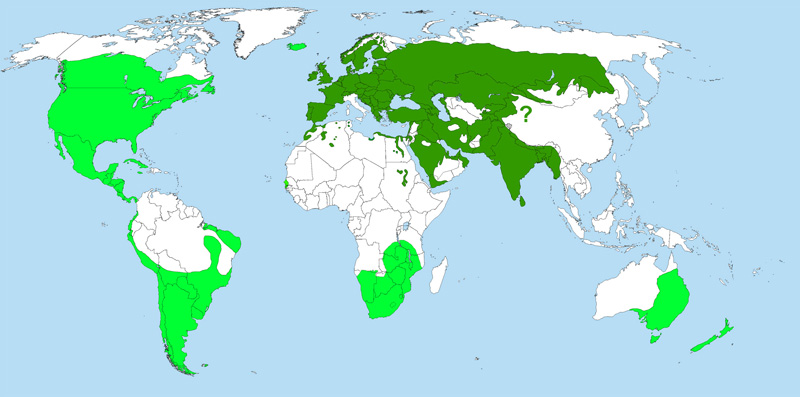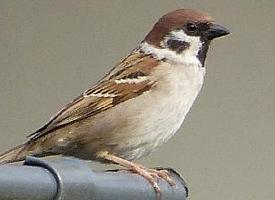
Poids et mesures
| Longueur | de 14 à 15 cm |
|---|---|
| Poids | 30 g |
| Envergure des ailes | 21 cm |
Description de l'animal
The House Sparrow (Passer domesticus) is a bird species renowned for its close association with human habitats, making it one of the most widely distributed and familiar wild birds in the world. Originating from Europe and Asia, these adaptable birds have been introduced to various parts of the globe, including the Americas, Africa, and Australia, where they thrive in urban and rural settings alike.Physical Characteristics:
House Sparrows are small, stout birds, measuring approximately 16 cm in length and weighing around 20-30 grams. They exhibit sexual dimorphism, meaning males and females can be distinguished by their appearance. Males typically have a striking pattern of colors: they boast a gray crown, cheeks, and underparts, with a distinctive black bib (throat and upper breast area) that varies in size with the seasons and the individual's status. Their back and wings are a mix of brown and black with white streaks, making them well-camouflaged in their typical habitats. Females and young sparrows, on the other hand, have a more subdued coloration, predominantly featuring shades of brown and gray, with lighter underparts. This cryptic coloration helps protect them from predators.
Behavior and Ecology:
House Sparrows are gregarious birds, often found in small to large flocks, especially during non-breeding seasons. They are highly adaptable, opportunistic feeders, with a diet that includes seeds, fruits, and insects. In urban areas, they are also known to consume food scraps discarded by humans. Their feeding behavior demonstrates remarkable flexibility, allowing them to exploit a wide range of environments.
House Sparrows typically nest in close association with humans, utilizing nooks and crannies in buildings, under eaves, and occasionally in more natural settings like tree hollows. They are known for their resourcefulness in constructing nests from a variety of materials, including grasses, feathers, paper, and twigs. The female lays between three to seven eggs per clutch, with both parents involved in feeding and raising the offspring.
Vocalizations:
Their vocal repertoire is diverse, consisting of a series of chirps, cheeps, and chirrups. The male's song, used to attract a mate and defend territory, is a simple, monotonous chirping sequence. These sounds play a crucial role in social interactions within flocks, helping maintain social bonds and communicate about food and threats.
Conservation Status:
The House Sparrow is listed as Least Concern by the International Union for Conservation of Nature (IUCN), reflecting its wide distribution and large population size. However, in some parts of its range, notably in Western Europe and North America, populations have shown significant declines due to factors such as habitat loss, pollution, and competition for nesting sites. These declines have sparked concern and led to efforts to better understand the challenges facing House Sparrows in the modern world.
In conclusion, the House Sparrow is a fascinating example of a species that has successfully coexisted with humans, benefiting from our alterations to the environment. Despite their common presence, the decline in certain areas serves as a reminder of the complex interactions between wild species and human-modified landscapes, highlighting the importance of ongoing conservation efforts to ensure these familiar birds remain a staple of urban and rural life.
Carte de répartition

Animaux similaires
Nouvelles photos d'animaux
Top 10 des animaux
- Dolphin gull (Leucophaeus scoresbii)
- Japanese macaque (Macaca fuscata)
- Stone loach (Barbatula barbatula)
- Greek tortoise (Testudo graeca)
- Russian tortoise (Testudo horsfieldii)
- Galápagos tortoise (Geochelone nigra complex)
- Diana monkey (Cercopithecus diana)
- Moustached guenon (Cercopithecus cephus)
- Common flying dragon (Draco volans)
- Galápagos penguin (Spheniscus mendiculus)

